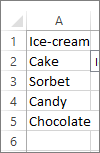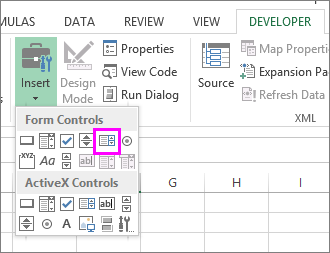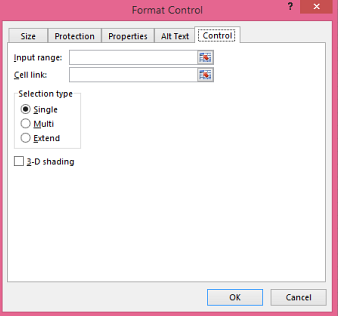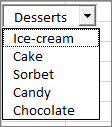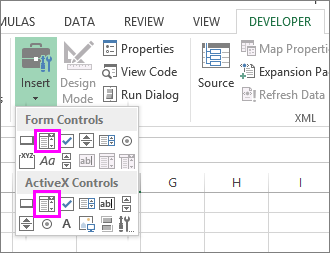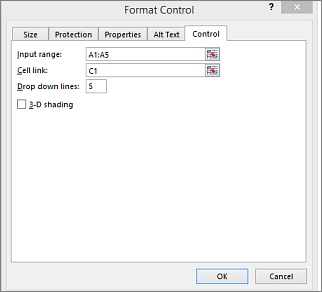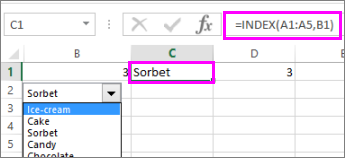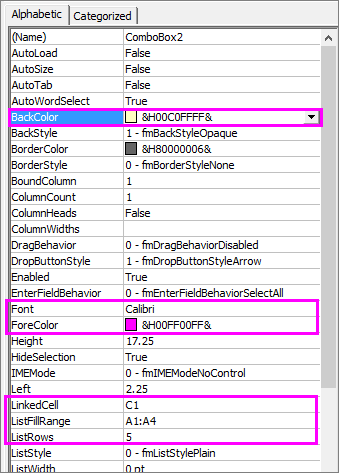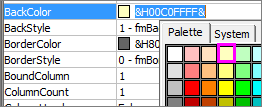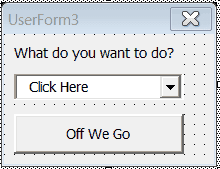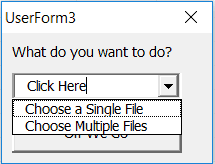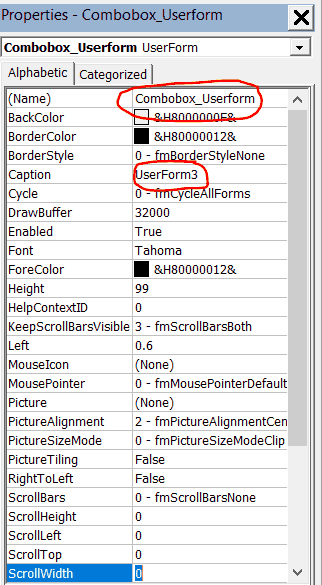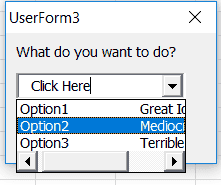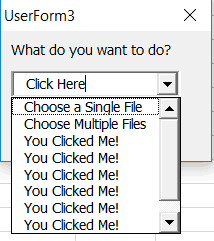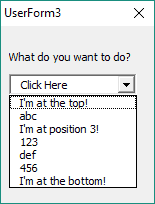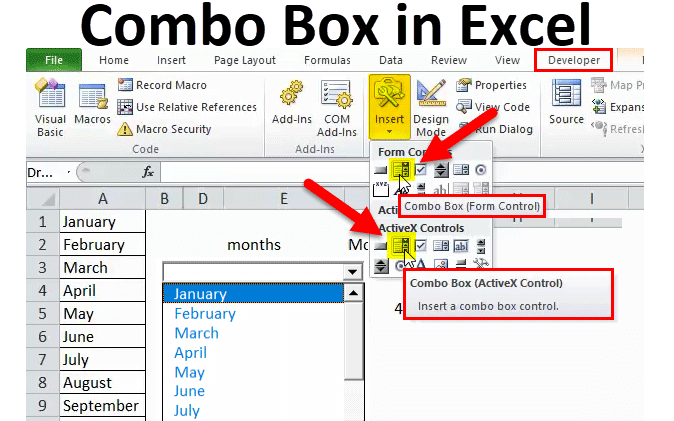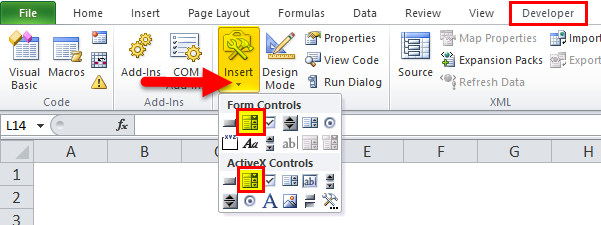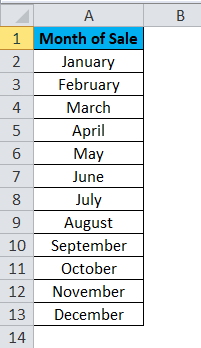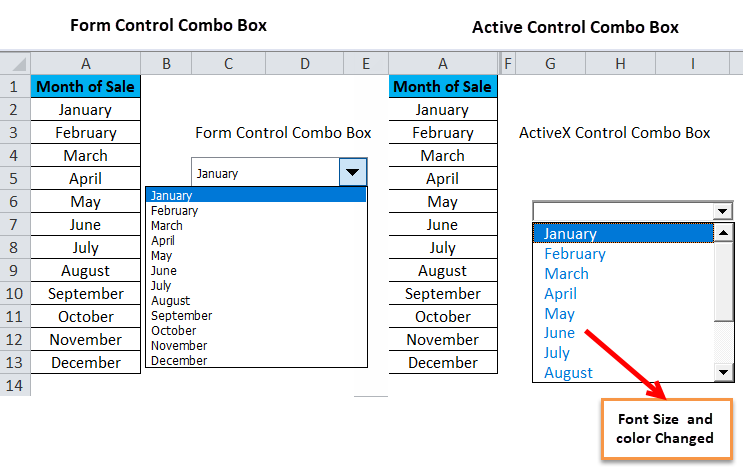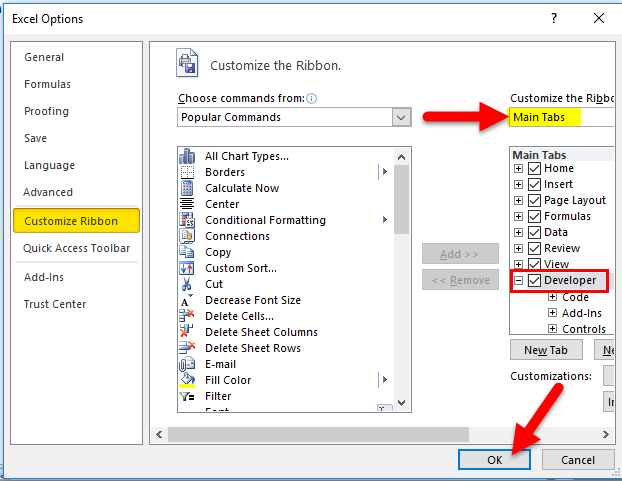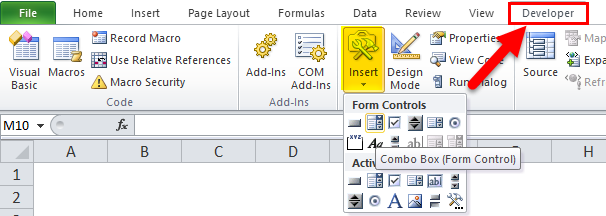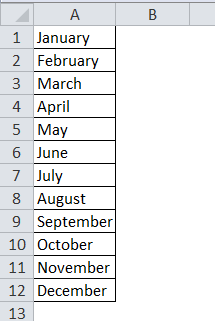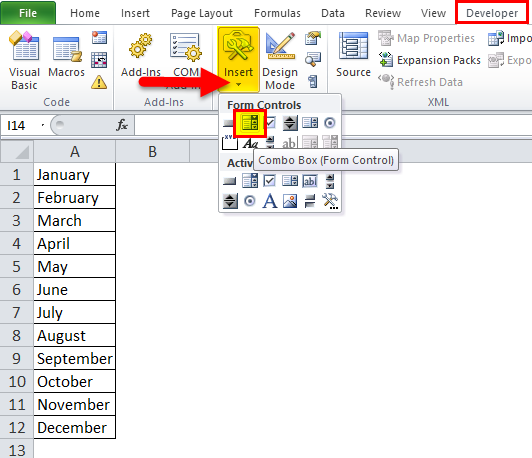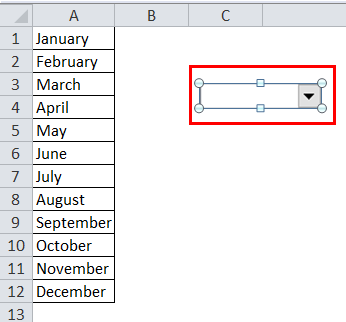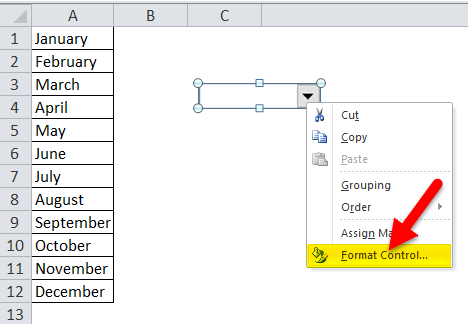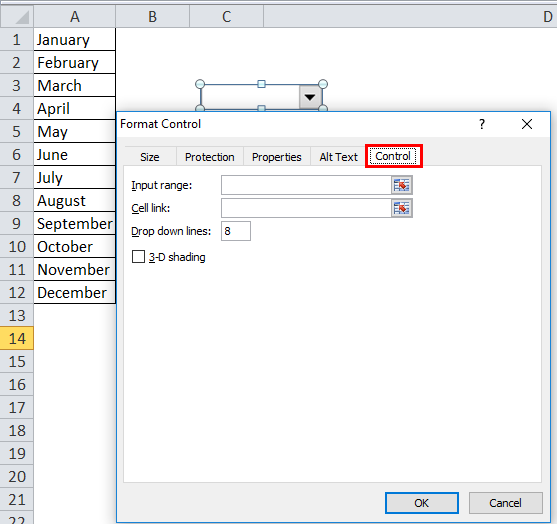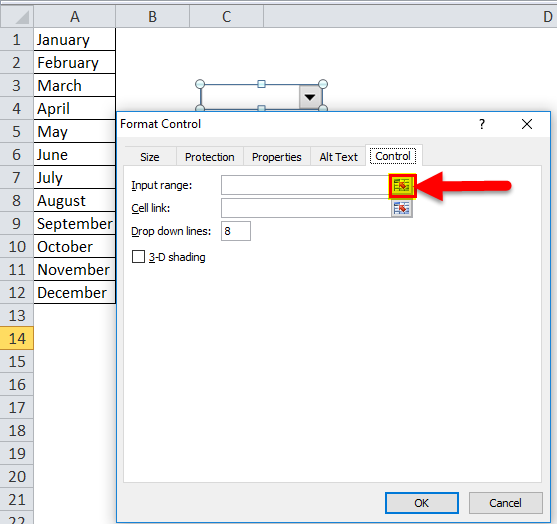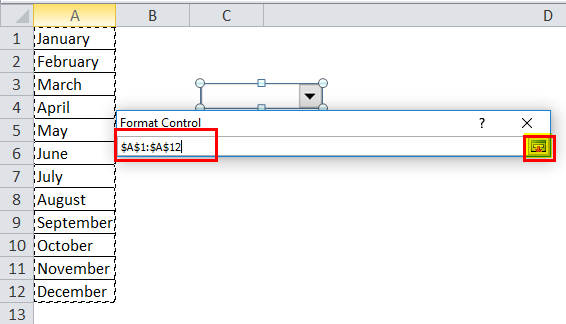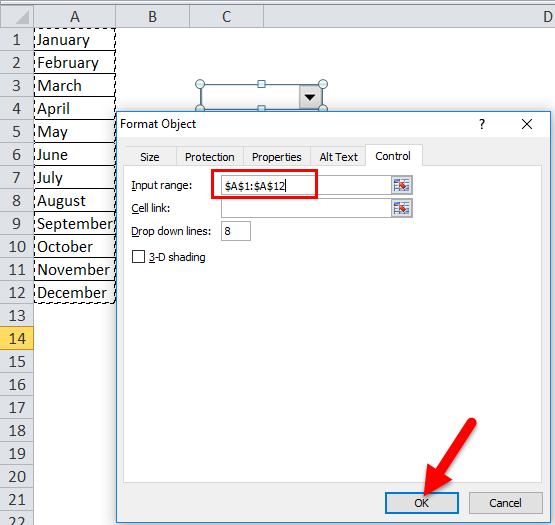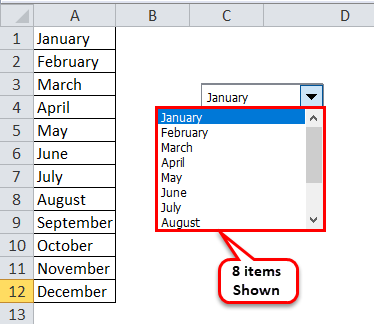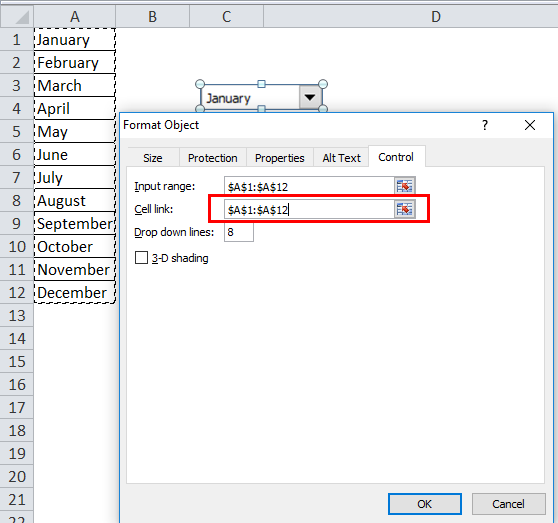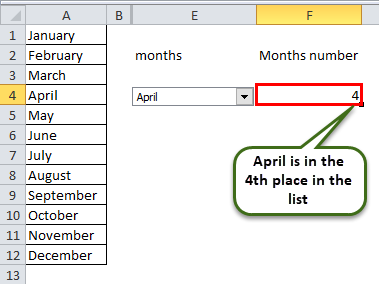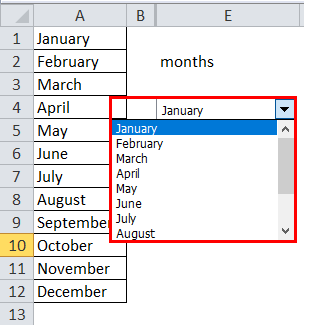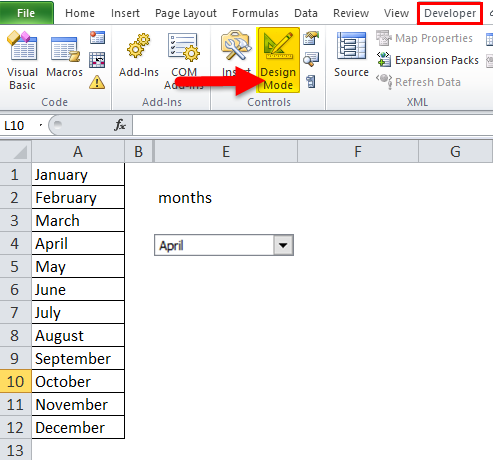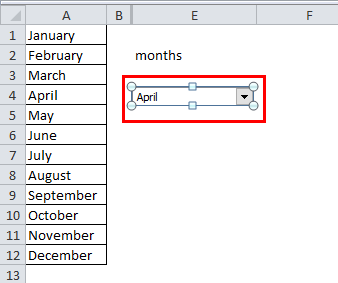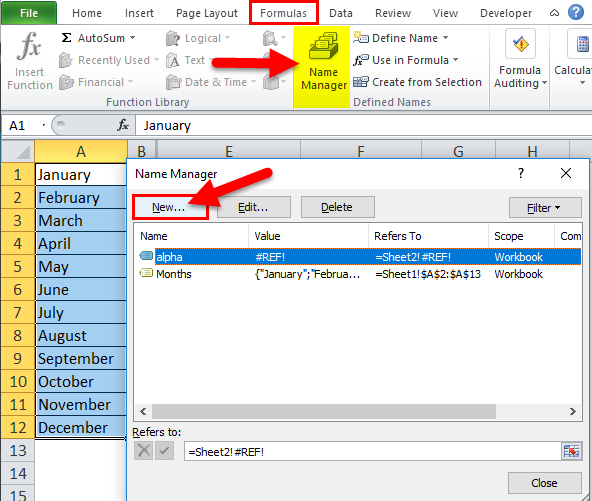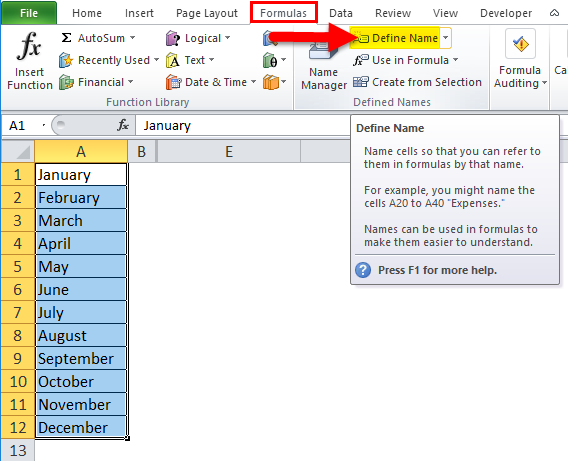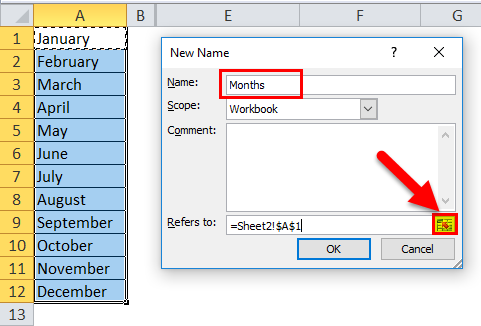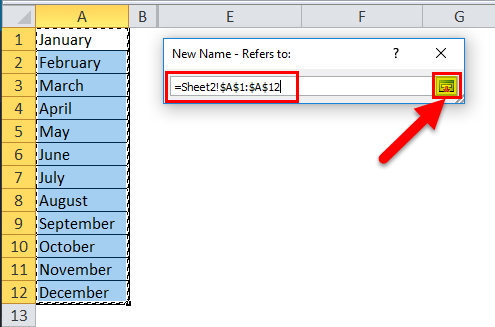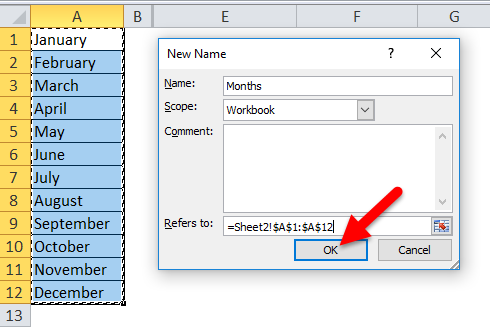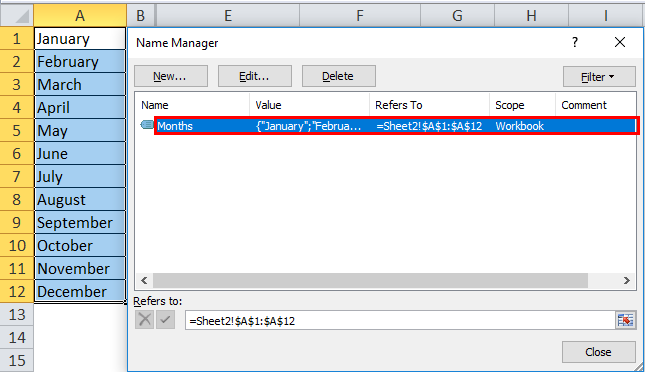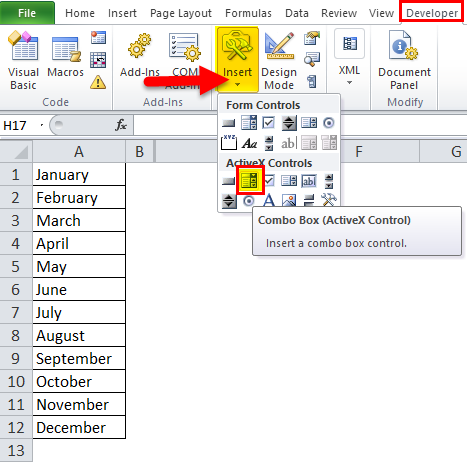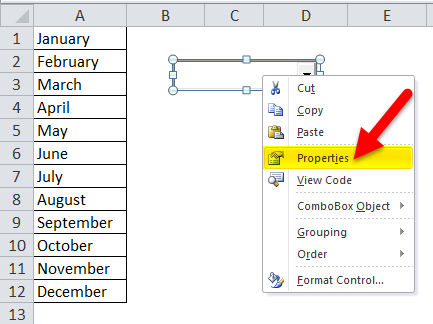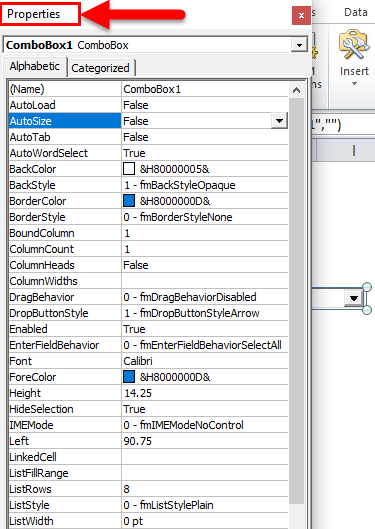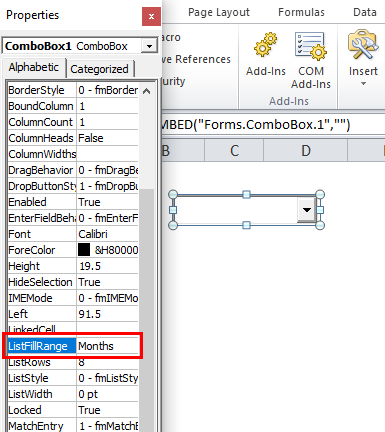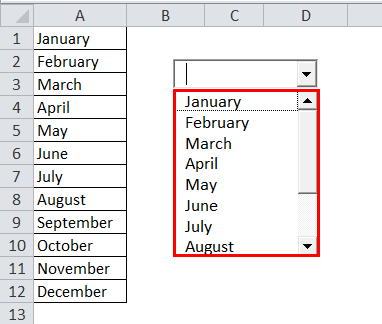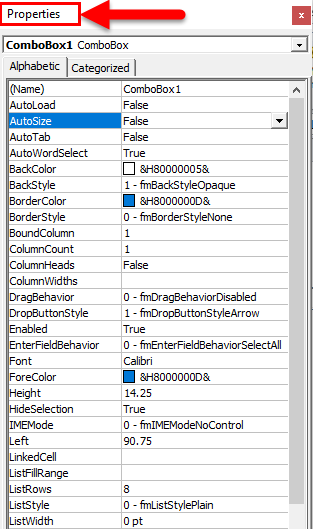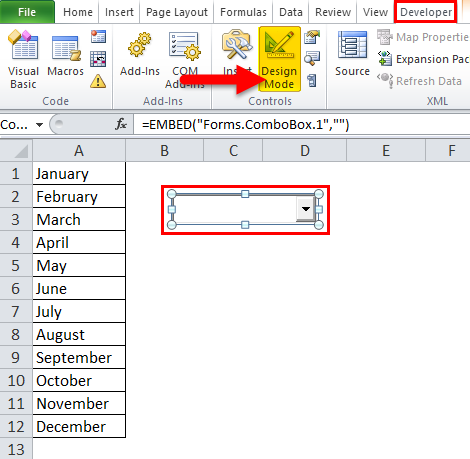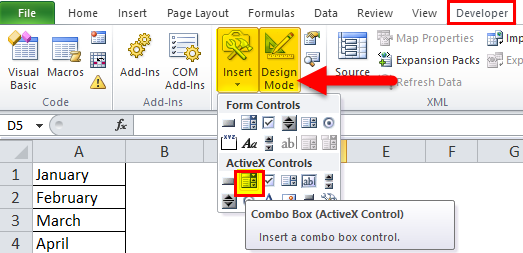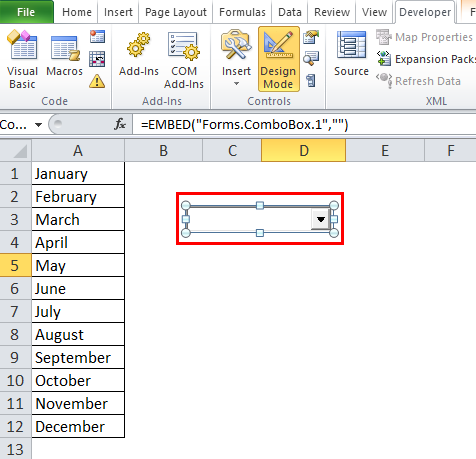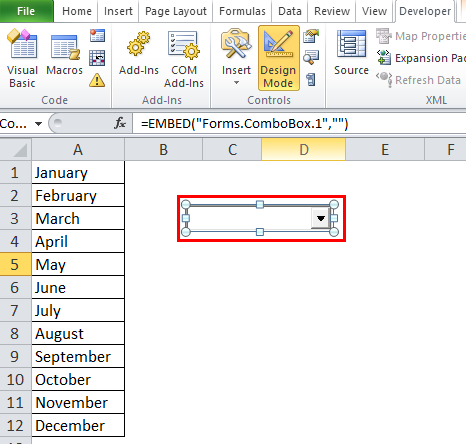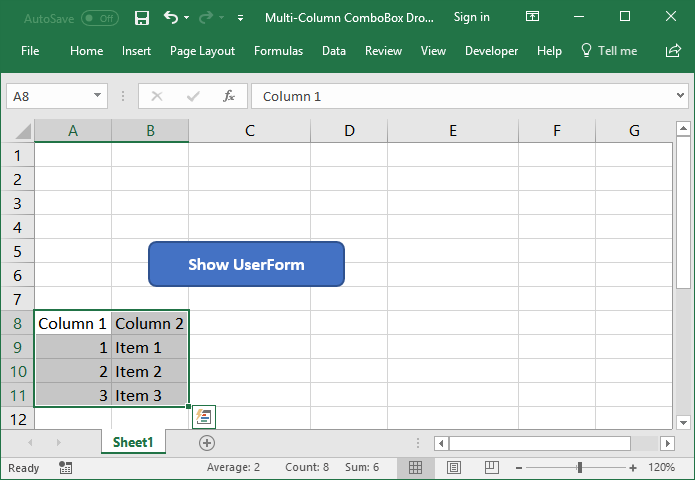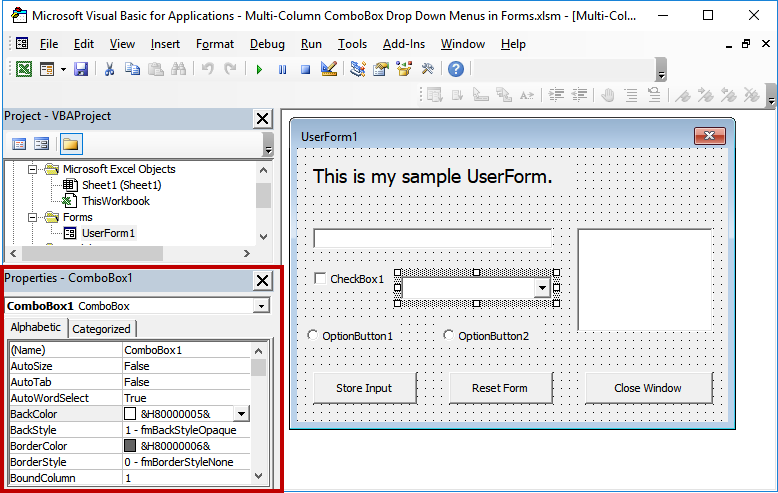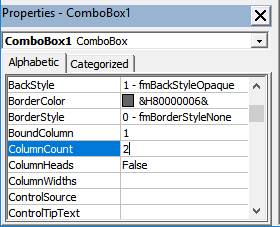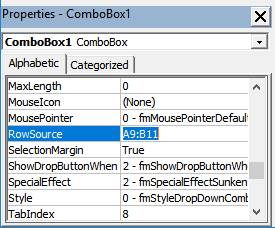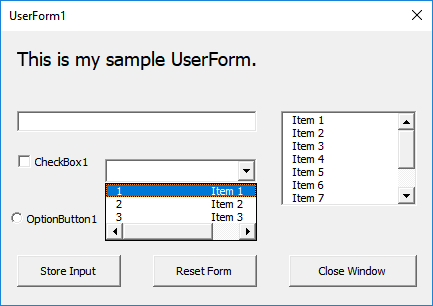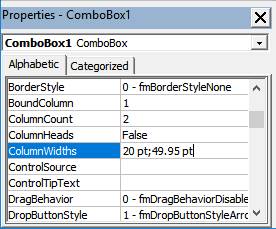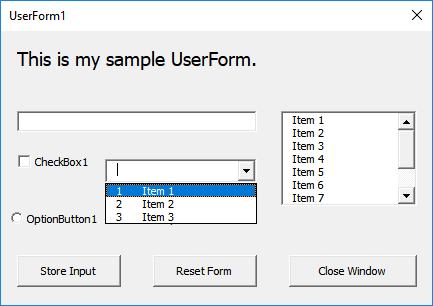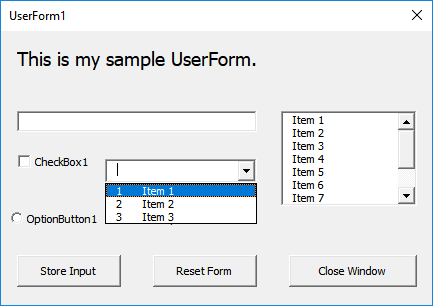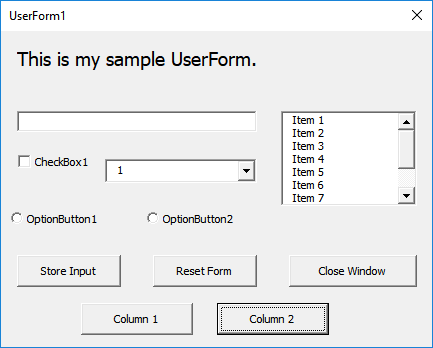Excel for Microsoft 365 Excel 2021 Excel 2019 Excel 2016 Excel 2013 Excel 2010 Excel 2007 Excel Starter 2010 More…Less
When you want to display a list of values that users can choose from, add a list box to your worksheet.

Add a list box to a worksheet
-
Create a list of items that you want to displayed in your list box like in this picture.
-
Click Developer > Insert.
Note: If the Developer tab isn’t visible, click File > Options > Customize Ribbon. In the Main Tabs list, check the Developer box, and then click OK.
-
Under Form Controls, click List box (Form Control).
-
Click the cell where you want to create the list box.
-
Click Properties > Control and set the required properties:
-
In the Input range box, type the range of cells containing the values list.
Note: If you want more items displayed in the list box, you can change the font size of text in the list.
-
In the Cell link box, type a cell reference.
Tip: The cell you choose will have a number associated with the item selected in your list box, and you can use that number in a formula to return the actual item from the input range.
-
Under Selection type, pick a Single and click OK.
Note: If you want to use Multi or Extend, consider using an ActiveX list box control.
-
Add a combo box to a worksheet
You can make data entry easier by letting users choose a value from a combo box. A combo box combines a text box with a list box to create a drop-down list.
You can add a Form Control or an ActiveX Control combo box. If you want to create a combo box that enables the user to edit the text in the text box, consider using the ActiveX Combo Box. The ActiveX Control combo box is more versatile because, you can change font properties to make the text easier to read on a zoomed worksheet and use programming to make it appear in cells that contain a data validation list.
-
Pick a column that you can hide on the worksheet and create a list by typing one value per cell.
Note: You can also create the list on another worksheet in the same workbook.
-
Click Developer > Insert.
Note: If the Developer tab isn’t visible, click File > Options > Customize Ribbon. In the Main Tabs list, check the Developer box, and then click OK.
-
Pick the type of combo box you want to add:
-
Under Form Controls, click Combo box (Form Control).
Or
-
Under ActiveX Controls, click Combo Box (ActiveX Control).
-
-
Click the cell where you want to add the combo box and drag to draw it.
Tips:
-
To resize the box, point to one of the resize handles, and drag the edge of the control until it reaches the height or width you want.
-
To move a combo box to another worksheet location, select the box and drag it to another location.
Format a Form Control combo box
-
Right-click the combo box and pick Format Control.
-
Click Control and set the following options:
-
Input range: Type the range of cells containing the list of items.
-
Cell link: The combo box can be linked to a cell where the item number is displayed when you select an item from the list. Type the cell number where you want the item number displayed.
For example, cell C1 displays 3 when the item Sorbet is selected, because it’s the third item in our list.
Tip: You can use the INDEX function to show an item name instead of a number. In our example, the combo box is linked to cell B1 and the cell range for the list is A1:A2. If the following formula, is typed into cell C1: =INDEX(A1:A5,B1), when we select the item «Sorbet» is displayed in C1.
-
Drop-down lines: The number of lines you want displayed when the down arrow is clicked. For example, if your list has 10 items and you don’t want to scroll you can change the default number to 10. If you type a number that’s less than the number of items in your list, a scroll bar is displayed.
-
-
Click OK.
Format an ActiveX combo box
-
Click Developer > Design Mode.
-
Right-click the combo box and pick Properties, click Alphabetic, and change any property setting that you want.
Here’s how to set properties for the combo box in this picture:
To set this property
Do this
Fill color
Click BackColor > the down arrow > Pallet, and then pick a color.
Font type, style or size
Click Font > the… button and pick font type, size, or style.
Font color
Click ForeColor > the down arrow > Pallet, and then pick a color.
Link a cell to display selected list value.
Click LinkedCell
Link Combo Box to a list
Click the box next to ListFillRange and type the cell range for the list.
Change the number of list items displayed
Click the ListRows box and type the number of items to be displayed.
-
Close the Property box and click Designer Mode.
-
After you complete the formatting, you can right-click the column that has the list and pick Hide.
Need more help?
You can always ask an expert in the Excel Tech Community or get support in the Answers community.
See Also
Overview of forms, Form controls, and ActiveX controls on a worksheet
Add a check box or option button (Form controls)
Need more help?
Содержание
- Свойство ComboBox.Column (Access)
- Синтаксис
- Параметры
- Замечания
- Пример
- Поддержка и обратная связь
- Things you can do with a multicolumn ListBox or ComboBox
- См. также
- Поддержка и обратная связь
- VBA Excel. Элемент управления ComboBox (поле со списком)
- Элемент управления ComboBox
- Свойства поля со списком
- Способы заполнения ComboBox
- adding two columns to vba userform combobox
- 3 Answers 3
- How to Populate ComboBox on VBA Userforms
- The VBA Tutorials Blog
- Create the UserForm
- Populate the VBA Combobox
- Accessing the Initialization Event
- Populate ComboBox with .List
- Populate ComboBox with a Range
- Populating Multi-Column ComboBox
- Populate ComboBox with .AddItem
- Add Item to Different Positions in ComboBox
- Conclusion
Свойство ComboBox.Column (Access)
Используйте свойство Column для ссылки на определенный столбец или сочетание столбцов и строк в поле со списком или списке с несколькими столбцами. Только для чтения, Variant.
Синтаксис
expression. Столбец (индекс, строка)
Выражение Переменная, представляющая объект ComboBox .
Параметры
| Имя | Обязательный или необязательный | Тип данных | Описание |
|---|---|---|---|
| Индекс; | Обязательный | Long | Длинное целое число, которое может варьироваться от 0 до параметра свойства ColumnCount минус один. |
| Row | Необязательный | Variant | Целое число, которое может варьироваться от 0 до параметра свойства ListCount минус 1. |
Замечания
Используйте 0 для ссылки на первый столбец, 1 — на второй столбец и т. д. Используйте 0 для ссылки на первую строку, 1 — на вторую строку и т. д. Например, в списке со столбцом идентификаторов клиентов и столбцом имен клиентов можно сослаться на имя клиента во втором столбце и пятой строке следующим образом:
Используйте свойство Column , чтобы назначить содержимое поля со списком или списка другому элементу управления, например текстовому поле. Например, чтобы задать для свойства ControlSource текстового поля значение во втором столбце списка, можно использовать следующее выражение.
Если пользователь не сделал выбор при ссылке на столбец в поле со списком или списке, параметр свойства Column будет иметь значение NULL. Используйте функцию IsNull , чтобы определить, был ли сделан выбор, как показано в следующем примере.
Чтобы определить, сколько столбцов содержит поле со списком или список, можно проверить параметр свойства ColumnCount .
Пример
В следующем примере свойства Column и ColumnCount используются для печати значений выделенного списка.
Поддержка и обратная связь
Есть вопросы или отзывы, касающиеся Office VBA или этой статьи? Руководство по другим способам получения поддержки и отправки отзывов см. в статье Поддержка Office VBA и обратная связь.
Источник
Things you can do with a multicolumn ListBox or ComboBox
Чтобы управлять шириной столбцов многоколонок ListBox или ComboBox, можно указать ширину (в точках) для всех столбцов в свойстве ColumnWidths . Если для какого-нибудь конкретного столбца задать нулевую ширину, этот столбец станет скрытым и не будет отображаться на экране.
Если вы хотите скрыть от пользователя все столбцы ListBox или ComboBox , кроме одного, можно задать значение ColumnWidths для других столбцов равным нулю и определить отображаемый столбец информации, оставив свойству ColumnWidths значение по умолчанию и используя свойство TextColumn . Когда пользователь выбирает строку, свойству Text элемента управления присваивается значение столбца, определяемого свойством TextColumn . В поле со списком система отображает столбец, назначаемый свойством TextColumn в текстовой части элемента управления.
Аналогичным образом можно указать, какой столбец значений используется для элемента управления, когда пользователь делает выбор, указав номер столбца в свойстве BoundColumn .
См. также
Поддержка и обратная связь
Есть вопросы или отзывы, касающиеся Office VBA или этой статьи? Руководство по другим способам получения поддержки и отправки отзывов см. в статье Поддержка Office VBA и обратная связь.
Источник
VBA Excel. Элемент управления ComboBox (поле со списком)
Элемент управления пользовательской формы ComboBox для выбора и ввода информации в VBA Excel. Свойства поля с раскрывающимся списком, заполнение, извлечение данных, примеры кода.
Элемент управления ComboBox
ComboBox представляет из себя комбинацию двух элементов управления: текстового поля (TextBox) и списка (ListBox), поэтому его еще называют «комбинированным списком» или «полем со списком». Также ComboBox сочетает в себе свойства этих двух элементов управления.
Изначально комбинированный список прорисовывается на форме в виде текстового поля с кнопкой для отображения раскрывающегося списка. Далее по тексту будем использовать слово «поле» в значении текстового поля в составе элемента управления ComboBox, а словосочетание «раскрывающийся список» – в значении списка в составе элемента управления ComboBox.
Поле со списком используется в тех случаях, когда необходимо добавить в форму информацию, которая заранее известна, а ее отдельные позиции можно сгруппировать в список, а также для ручного ввода с клавиатуры или вставки из буфера обмена, если необходимое значение в списке отсутствует.
Элемент управления ComboBox незаменим при больших списках. При списках из нескольких позиций его можно заменить на ListBox, который отображает позиции для выбора сразу после загрузки формы, не требуя дополнительных действий от пользователя.
Свойства поля со списком
| Свойство | Описание |
|---|---|
| AutoSize | Автоподбор размера комбинированного поля. True – размер автоматически подстраивается под длину выбранной или введенной строки. False – размер элемента управления определяется свойствами Width и Height. |
| AutoTab | Включение автоматической табуляции – передачи фокуса следующему элементу управления при достижении максимального числа символов при значениях свойства MaxLenght > 0. True – автоматическая табуляция включена, False – выключена. |
| ColumnCount | Указывает количество столбцов в раскрывающемся списке. Значение по умолчанию = 1. |
| ColumnHeads | Добавляет строку заголовков в раскрывающийся список. True – заголовки столбцов включены, False – заголовки столбцов выключены. Значение по умолчанию = False. |
| ColumnWidths | Ширина столбцов в раскрывающемся списке. Значения для нескольких столбцов указываются в одну строку через точку с запятой (;). |
| ControlSource | Ссылка на ячейку для ее привязки к элементу управления ComboBox. |
| ControlTipText | Текст всплывающей подсказки при наведении курсора на элемент управления. |
| Enabled | Доступ пользователя к полю и раскрывающемуся списку. True – доступ разрешен, False – доступ запрещен*. Значение по умолчанию = True. |
| Font | Шрифт, начертание и размер текста в поле. |
| Height | Высота элемента управления ComboBox. |
| Left | Расстояние от левого края внутренней границы пользовательской формы до левого края комбинированного списка. |
| List | Позволяет заполнить ComboBox данными из одномерного или двухмерного массива, а также обращаться к отдельным элементам раскрывающегося списка по индексам для записи и чтения. |
| ListIndex | Номер выбранной пользователем строки в раскрывающемся списке. Нумерация начинается с нуля. Если ничего не выбрано, ListIndex = -1. |
| ListRows | Количество видимых строк в раскрытом списке. Если общее количество строк больше ListRows, появляется полоса прокрутки. Значение по умолчанию = 8. |
| Locked | Запрет на отображение раскрывающегося списка, ввод и редактирование данных в поле. True – ввод и редактирование запрещены**, False – ввод и редактирование разрешены. Значение по умолчанию = False. |
| MatchRequired | Задает проверку вводимых в поле строк с элементами списка. True – проверка включена (допускается ввод только строк, совпадающих с элементами списка), False – проверка выключена (допускается ввод любых строк). Значение по умолчанию = False. |
| MaxLenght | Максимальная длина строки в поле. Значение по умолчанию = 0, что означает – ограничений нет. |
| RowSource | Источник строк для раскрывающегося списка (адрес диапазона на рабочем листе Excel). |
| TabIndex | Целое число, определяющее позицию элемента управления в очереди на получение фокуса при табуляции. Отсчет начинается с 0. |
| Text | Текстовое содержимое (значение) поля (=Value). |
| TextAlign | Выравнивание текста в поле: 1 (fmTextAlignLeft) – по левому краю, 2 (fmTextAlignCenter) – по центру, 3 (fmTextAlignRight) – по правому краю. |
| Top | Расстояние от верхнего края внутренней границы пользовательской формы до верхнего края комбинированного списка. |
| Value | Текстовое содержимое (значение) поля (=Text). |
| Visible | Видимость поля со списком. True – ComboBox отображается на пользовательской форме, False – ComboBox скрыт. |
| Width | Ширина элемента управления. |
* При Enabled в значении False пользователь не может раскрывать список, а также вводить или редактировать данные в поле.
** Для элемента управления ComboBox действие свойства Locked в значении True аналогично действию свойства Enabled в значении False.
В таблице перечислены только основные, часто используемые свойства поля со списком. Еще больше доступных свойств отображено в окне Properties элемента управления ComboBox, а все методы, события и свойства – в окне Object Browser.
Вызывается Object Browser нажатием клавиши «F2». Слева выберите объект ComboBox, а справа смотрите его методы, события и свойства.
Свойства BackColor, BackStyle, BorderColor, BorderStyle отвечают за внешнее оформление комбинированного списка и его границ. Попробуйте выбирать доступные значения этих свойств в окне Properties, наблюдая за изменениями внешнего вида элемента управления ComboBox на проекте пользовательской формы.
Способы заполнения ComboBox
Используйте метод AddItem для загрузки элементов в поле со списком по одному:
Источник
adding two columns to vba userform combobox
i have that userform for stock control which used to in or out items, all i want to do to amend the below code to show each item name beside it`s code to make searching items. Code:
photo indicating the required amendment
I want it to be like:
3 Answers 3
To do this:
Set the ColumnCount = 2 for ComboBox
Set the 2nd column value by ComboBox1.Column(1,) = ‘the value’`. In your code. it should be like:
For i = 2 To final tareas = Hoja5.Cells(i, 1) ComboBox1.AddItem (tareas) ‘— set the first column ComboBox1.Column(1, i — 2) = Hoja5.Cells(i, 2) ‘the name Next
You need to specify the ColumnCount value, and provide an array for the List property. If you want you can also specify a string containing a comma-separated list of column widths for the ColumnWidths property, too:
Suppose you have a ListObject on a worksheet:
The code that works with the UserForm1 instance is responsible for calling the PopulateComboBox method:
Quite often, you want ComboBox.Text to be something user-friendly, and ComboBox.Value to be something useful — like some ID value:
The problem with doing that is that the ComboBox will always use the contents of the first column in its source for display, so you get this:
The solution is simply to hide the first column (i.e. set its width to 0 ):
Since valueColumn is 1 , Me.ComboBox1.BoundColumn is referring to the hidden ID column, so when we do this:
This is what’s printed in the immediate pane after selecting Lord of the Rings:
ComboBox1.Value is 1 , and ComboBox1.Text is Lord of the Rings : now the rest of your code doesn’t have to deal with string literals!
Источник
How to Populate ComboBox on VBA Userforms
The VBA Tutorials Blog
The ComboBox is a Control for VBA userforms that allows the user to choose from a list of options. It is also known as a drop-down menu, but to serve its purpose as a dropdown menu, you’ll first need to populate the combobox for the user so they can actually make a choice. There are two ways to populate a ComboBox with VBA:
- With the .AddItem method
- With the .List property
The rest of this tutorial will teach you how to add entries to, or populate, your own VBA userform comboboxes, and we’ll have a little fun teaching it!
Create the UserForm
Before we write any code to populate our combobox, we need to create the box itself and the userform on which it lives.
I’m sure you already have your own design, but in this tutorial, our userform will carry the name Combobox_Userform , our command button will be CmdButton_For_CB , and the combobox itself will be ComboBox_Demo1 .
Here is what the layout looks like:
Userform with three elements: a combobox, a label, and a button
As you can see, we put default text “Click Here” into the combobox. This is not one of the dropdown options; it’s simply a filler before the user clicks the menu. You can edit it directly by clicking into the combobox in the preview window, just like for the Label and CommandButton controls, but what you really want to do is populate your combobox using VBA code, like we’ll demonstrate in the next section.
Populate the VBA Combobox
In this section, we will show you how to populate a combobox in the UserForm_Initialize VBA Event by either adding items sequentially or reading the values directly from an array.
Accessing the Initialization Event
VBA hands control off to the UserForm_Initialize Event only after the userform has been called. If you want a more in-depth discussion about the logic of showing a userform, check out our Userform Show article. In short, here’s the code for showing our particular userform:
Make sure you place this in a regular Module, not the userform’s dedicated private code.
Populate ComboBox with .List
Now we’re going to begin actually populating the values in our ComboBox. One way to add multiple values to your ComboBox is to use the ComboBox List property, or .List .
To use the ComboBox .List property, you simply need to put your dropdown menu options into an array and separate each dropdown item by a comma. You can use the Array function to create the array needed for the .List property. Don’t forget each option needs quotes since your entries are strings!
Here’s a sample code that goes into the userform’s private code, not a regular module, and adds two items to your dropdown list once the userform is initialized:
Make powerful macros with our free VBA Developer Kit
Tutorials like this can be complicated. That’s why we created our free VBA Developer Kit and our Big Book of Excel VBA Macros to supplement this tutorial. Grab them below and you’ll be writing powerful macros in no time.
When you run this code, you’ll get this beauty:
The userform with populated combobox open
Notice the userform’s caption is “UserForm3”, but the userform name is ComboBox_Userform . I’m pointing this out because the same distinction applies to your combobox. Don’t get the (Name) and Caption or Text values mixed up! You will get a runtime error if you try to use the caption as the object name. You can change the object name and caption in the Properties window (F4), typically on the bottom left of the VBE.
The Properties Window for Combobox_Userform with the Caption and Name Circled
Populate ComboBox with a Range
You can also use the .List property to populate a userform combobox with a range of cells in your spreadsheet. Take this macro, for example:
This macro will quickly add all the values in range A1:A10 to your ComboBox. It’s incredibly fast and very helpful if your userform is designed to accept data from your spreadsheet.
Populating Multi-Column ComboBox
Speaking of columns of data, the .List property also has an optional second argument, pvargColumn, to let you populate specific columns of a multicolumn ComboBox.
If you want to use the optional arguments in the .List property to create multi-columned comboboxes, there are some extra steps to take.
First you need to change the number of columns in your combobox, much like you would in my tutorial on aligning columns differently in a UserForm ListBox. You can do this under the Properties window mentioned earlier, or you can do it at runtime by using the .ColumnCount property of the combobox object, like this:
Then, you can create a dummy array that matches the dimensions you want for the list of options. Remember the .List array is zero-based. Let’s say you want a 3-row, 2-column list with any kind of data, like numbers or dates, so you dimensionalize an array, like this:
From here, you have two choices. You can either (1) populate your array and then populate your ComboBox with your full array, or (2) populate your ComboBox with an empty array and then fill each array element individually.
Either way, we’ll use the .List property, just like before, to add items to your ComboBox. The second option accesses each “cell” in the list to fill out the final dropdown menu.
Option 1: Pass Full Array to ComboBox
Option 2: Pass Empty Array to ComboBox
Whichever option you choose, you’ll be left with a nice two-column, three-row VBA ComboBox that’s fully populated, like this one:
A Populated Multi-Column ComboBox
Populate ComboBox with .AddItem
If instead you want to add items with methods (as opposed to properties), you can use the ComboBox .AddItem method during initialization. Each time you call the AddItems method, a new item will appear in your ComboBox.
More interestingly, you can use .AddItems to add items dynamically after the userform has already been created.
In code, populating your UserForm ComboBox dynamically would look something like this:
We used the Event UserForm_Click , so when the user clicks on the userform area, an item is added to the bottom of our dropdown list. The initial userform has the default values we added with the .List property, but now we let the user add items by clicking on the userform, as well.
The dropdown menu after clicking on the userform several times
I know this is a silly example, but it demonstrates how you can dynamically alter your combobox when certain conditions are met; in this case, when the user clicks the form.
You could also populate the list with .AddItem in the initialization stage if you wanted, like this:
The VBA ComboBox AddItem method is the most popular way to add items to a userform, although I’ve found both options to be equally flexible.
Imagine you had a lot of rows in a text file or something that you wanted to add to your combobox. You could nest the .AddItem method inside a For Loop to programatically add each item. Placing the AddItem ComboBox method inside a loop is a common practice for populating a UserForm ComboBoxes.
Add Item to Different Positions in ComboBox
The AddItem method of userform comboboxes also accepts an optional second argument: pvargIndex. When included, the pvargIndex tells your combobox where you want to add your new entry.
The items in your combobox range from 0 (at the top) to .ListCount (at the bottom). For example, if you fed the argument a 0, it would add a new entry to the top of your userform. Omitting the argument is the same as passing the AddItem method an argument of ComboBox_Demo1 .ListCount .
Let’s look at a couple examples. In the following code, the “You Clicked Me!” item is added in the first position instead of the default last position.
to place the code at the top of your ComboBox (Position 0).
Let’s take a look at one more example.
In this example, we dynamically populated our combobox by adding an item to the top, bottom and at the 3rd entry in the dropdown menu by specifying a pvargIndex position. Notice how a pvargIndex of 2 added an item to the 3rd slot. Remember, ComboBox indexing begins at position 0!.
pvargIndex to add items to ComboBox
Conclusion
Creative developers can use both .List and .AddItem to make interactive userform dropdown lists. By using ComboBoxes (or dropdowns), developers are able to guide user interactions with the program while still allowing a degree of freedom to the end users.
We hope you enjoyed this tutorial. To take your VBA skills to the next level, check out more of our free VBA tutorials. Test your skills by trying to link concepts. For example, can you combine [VBA GetOpenFilename] feature with a ComboBox for an interactive dropdown. When you’re ready to take your VBA to the next level, subscribe using the form below.
Ready to do more with VBA?
We put together a giant PDF with over 300 pre-built macros and we want you to have it for free. Enter your email address below and we’ll send you a copy along with our VBA Developer Kit, loaded with VBA tips, tricks and shortcuts.
Before we go, I want to let you know we designed a suite of VBA Cheat Sheets to make it easier for you to write better macros. We included over 200 tips and 140 macro examples so they have everything you need to know to become a better VBA programmer.
This article was written by Cory Sarver, a contributing writer for The VBA Tutorials Blog. Visit him on LinkedIn and his personal page.
Источник
Table of Contents
- Combo Box in Excel
- How to Create Combo Box in Excel?
- Form Controls “Combo Box” in Excel
- ActiveX Control Combo Box in Excel
- Steps to delete Active X Control Combo Box in Excel
Combo Box in Excel
Combo Boxes in excel is not used for VBA Code but also for Excel spreadsheets. It is available under the Insert option of the Developer menu tab. These boxes are drop-down kind of elements that allow the user to select any value from the values listed in the Combo Box drop-down list. To select the Combo box option from Insert drop down and drop it anywhere in the sheet. And to add the values into the list, click right and select Format Control, select the input range and cell link.
There are two options for creating a “Combo Box” in Excel:
- Form Controls “Combo Box”:- It comes inbuilt with excel. In this type of control box, users cannot make changes to properties.
- ActiveX Controls “Combo Box”: – It is more versatile than form control. In this type of control box, a user can make changes to properties.
An example used for the two methods
In order to distinguish between the two combo boxes, let us look at the following examples –
How to Create Combo Box in Excel?
Initial steps before creating a Combo Box in Excel
You can download this Combo Box Excel Template here – Combo Box Excel Template
In case the Developer tab is visible beside the View tab in the Excel Ribbon then,
- Click on Developer-> Insert-> select “Combo Box” from either Form Controls or ActiveX Controls options.
In case the Developer tab is not visible beside the View tab in the Excel Ribbon then,
- Click on File -> Options.
- “Excel Options” dialogue box will be displayed as shown below. Click “Customize Ribbon”. Under the “Customize the Ribbon” drop-down box, select the “Main Tabs” value, selected by default, on the right panel. In the “Main Tabs” panel, select the Developer check box. Click Ok.
- You should now find the Developer tab in your Excel Ribbon.
- Create a simple list of values in the worksheet to start with, irrespective of the type of “Control Box”.
Form Controls “Combo Box” in Excel
Steps to create:
- Go to the Developer tab in the Excel Ribbon -> click Insert -> click on “Combo Box” under “Form Controls”.
- Click on the Excel Sheet at a location where you want to place the “Combo Box”. You may select the “Combo Box” and drag any of the small squares in the middle of the boundaries or circles in the corners to change the “Combo Box” size.
- Right, click on the new “Combo Box” -> select “Format Control”. The “Format Control” dialog box will appear.
- Select Control
- Click on the button to the right of the “Input range”.
- Select the cell range for the values in the list, which auto-populates the input box. Click on the highlighted button.
- Click OK in the “Format Object” dialog box.
Note: Drop down lines =8(by default) can be configured to show a number of items in the “Combo Box”.
- It Shows 8 number of items in the dropdown list.
Cell link – Enter cell number to display the position of a selected value in the list.
- It shows the position of months.
- Now you will be able to click on the drop-down arrow of the new “Combo Box” to see the list.
Steps to delete Form Controls “Combo Box” in Excel
- Go to Developer tab -> “Design Mode.”
- Select the Form Controls “Combo Box” and press Delete.
Point to be remembered
- It helps the user to choose a value from the range of items.
- In Form Control Combo Box, a user cannot make changes in the properties.
ActiveX Control Combo Box in Excel
The procedure to create ActiveX Control “Combo box” is a bit different from that of Form Control “Combo Box”.
Steps to create ActiveX Control Combo Box in Excel
- Follow either of the 2 ways to view the “New Name” dialog box –
- Go to Formula tab -> click on “Name Manager” -> Click New in the “Name Manager” dialog box.
OR
- Go to Formula tab -> click “Define Name”.
- Enter Name, Months. Click on the button to the right of the “Refer to” input box.
- Select the cell range which auto-populates the “Refers to” input box. Click on the highlighted button.
- Click OK in the restored “New Name” dialogue box.
- You will find a new range by the name”Months” in the “Name Manager” list.
- To create the “Combo Box”, we need to select “Combo Box” under “ActiveX Controls”.
- Click on the Excel Sheet at a location where you want the “Combo Box” to be placed. Right, click on the “Combo Box” -> click on Properties.
- A properties dialog box will appear.
- In the Properties dialog box, in the ListFillRange field, type the name of the named range, e.g. Months, that we have created above. Click on X in the upper right corner of the dialog box to close the same.
- Save the file with the “.xlsm” extension and reopen the file.
- Click on a pointer in “Combo Box” to see the list of values.
- To edit various properties, e.g. font size, color etc., make changes through a Properties dialog box.
To select/deselect “Combo Box”, click on “Design Mode” in the controls group of the Developer.
- To deselect “Combo Box”, deselect “Design Mode”.
- To select “Combo Box”, select “Design Mode”.
- Select “Combo Box” as shown in the following.
Steps to delete Active X Control Combo Box in Excel
- Go to the Developer tab, turn on “Design mode”.
- Select the Active X control combo box that you want to delete and press Delete.
Things to Remember
- It is more versatile.
- It allows the user to type the value in the text box from the range of items.
- In ActiveX Control “Combo Box”, the user can edit properties, e.g. font size, colors, etc.
- It is commonly used as a user interface control where users can select an item as per their own choice.
- It makes data entry easier and has many features and flexibility.
Recommended Articles
This is a guide to Combo Box in Excel. Here we discuss its uses and how to create Combo Box in Excel with excel examples and downloadable excel templates. You may also look at these useful functions in excel –
- Box Plot in Excel
- Combo Chart in Excel
- Name Box in Excel
- Excel Search Box
Multiple columns of data within a UserForm ComboBox drop-down menu in Excel.
I’ll show you an easy way to do this and a more complex way to do this using VBA.
Sections:
Multi-Column ComboBox from Worksheet Data (Easy Method)
Multi-Column UserForm ComboBox using VBA
Get Data from any Column of the ComboBox
Notes
Multi-Column ComboBox from Worksheet Data (Easy Method)
This is the easiest method, but it also requires that you keep your list of data within the worksheet in Excel.
- Setup your data in columns like this in the worksheet:
You can have as many columns as you need and you could place them on any worksheet, even hidden ones. - Go to the VBA window (Alt + F11) > Double-click the UserForm from the Project Explorer (Ctrl + R) > Click on the ComboBox and look to the Properties Window (F4).
- Change the ColumnCount property to the number of columns that you have.
- Go to the RowSource property and input the range reference of the data for the menu. In this example, it is A9:B11.
- That’s it!
Run the form and you’ll see the multi-column ComboBox:
Adjust the Column Width
You may notice that the widths of the columns in the menu are not good, they are too big, and this is also easy to fix.
Look to the ColumnWidths property and set the width for each column of data.
Separate the widths of each column using a semicolon. If you have 2 columns it could be like 20;50 and for three columns 20;50;30 etc.
Here, I entered 20 for the first column and 50 for the second column — Excel will automatically place the «pt» at the end of it once you enter the numbers and run the form.
Play around with the numbers until it fits your data.
Here is what the menu in our form now looks like after adjusting the column widths:
Multi-Column UserForm ComboBox using VBA
You can manage and maintain multi-column lists within the code for a UserForm; however, this can be a lot more confusing than the other method, which was illustrated above.
The code for this goes into the UserForm_Initialize() event inside the code section for the form. (In the Project Explorer, right-click the form and click View Code and then select UserForm from the left drop-down and Initialize from the right drop-down menu.)
The name of the ComboBox is ComboBox1.
First, declare a variable that says how many rows the list will be:
Dim RowValue(2, 1) As Variant2 is the number or total rows minus 1.
1 is the number of total columns minus 1.
Tell the form how many columns there will be in the ComboBox:
ComboBox1.ColumnCount = 2Tell the form how wide each column will be:
ComboBox1.ColumnWidths = "20;50"20 is for the first column.
50 is for the second column.
Each column is separated with a semicolon. Play around with the widths until your data fits nicely.
Add the Data:
'Row 1
RowValue(0, 0) = "1"
RuowVale(0, 1) = "Item 1"
'Row 2
RowValue(1, 0) = "2"
RowValue(1, 1) = "Item 2"
'Row 3
RowValue(2, 0) = "3"
RowValue(2, 1) = "Item 3"Note: the rows and columns start with zero and not 1!
Here is how to reference the rows and columns:
Row 1 Column 1: RowValue(0, 0)
Row 1 Column 2: RowValue(0, 1)
Row 2 Column 1: RowValue(1, 0)
Row 2 Column 2: RowValue(1, 1)
Etc.
Follow the pattern to add more rows and more columns.
Put the Values into the ComboBox:
ComboBox1.List = RowValueAll Code Put Together
'Add items to the ComboBox - Multi-Column
'Declare the array variable.
'Say how many rows there will be.
Dim RowValue(2, 1) As Variant
'Say how many columns there will be
ComboBox1.ColumnCount = 2
'Set Column Widths
ComboBox1.ColumnWidths = "20;50"
'Row 1
RowValue(0, 0) = "1"
RowValue(0, 1) = "Item 1"
'Row 2
RowValue(1, 0) = "2"
RowValue(1, 1) = "Item 2"
'Row 3
RowValue(2, 0) = "3"
RowValue(2, 1) = "Item 3"
'Put the values into the ComboBox
ComboBox1.List = RowValueResult
Get Data from Any Column of the ComboBox
When you get values from a multi-column ComboBox, you have to choose which data from which column you will get.
ComboBox1.Column(0)ComboBox1 is the name of the ComboBox.
Column(0) specifies from which column to get the data. Zero (0) is the first column; 1 is the second column; etc.
In the attached file for this tutorial, two buttons have been added to display these values in a message box pop-up window. Column 1 and Column 2
Note: no error-check has been implemented in this example; this means that you will get an error if you click the Column 1 or Column 2 buttons without first making a selection from the ComboBox.
Notes
Multi-column ComboBox controls can be tricky and annoying to maintain. Only use them if you really must use them.
Download the sample file for this tutorial to see these examples in Excel. (In the sample file, the Column 1 and Column 2 buttons will cause an error if you click them before making a selection from the ComboBox; this isn’t a big deal; I wanted the examples to be as easy-to-understand as possible and so error-checking code was omitted.)
Similar Content on TeachExcel
Complex Structured References (Table Formulas) in Excel
Tutorial:
How to use complex structured references, table formulas, in Excel.
If you don’t already…
Ignore Blanks in a Data Validation List in Excel
Tutorial:
I will show you 3 ways to remove the blanks from a Data Validation dropdown menu in Excel…
Multi-Page UserForm
Tutorial: You can have multiple tabs of data on a single UserForm and this allows you to, effectivel…
Multiple Selections in a ListBox
Tutorial: There are two different kinds of multiple item selections that you can have for a ListBox …
SUMIFS Examples in Excel
Tutorial:
Excel tutorial for the SUMIFS function — this includes 15 different examples that show yo…
8 Tips to Become an Expert in Conditional Formatting for Excel
Tutorial:
Become a master of Conditional Formatting in Excel! This tutorial covers 8 tips and trick…
Subscribe for Weekly Tutorials
BONUS: subscribe now to download our Top Tutorials Ebook!
Элемент управления пользовательской формы ComboBox для выбора и ввода информации в VBA Excel. Свойства поля с раскрывающимся списком, заполнение, извлечение данных, примеры кода.
UserForm.ComboBox – это элемент управления пользовательской формы, предназначенный для передачи в код VBA информации, выбранной пользователем из раскрывающегося списка или введенной с клавиатуры.
ComboBox представляет из себя комбинацию двух элементов управления: текстового поля (TextBox) и списка (ListBox), поэтому его еще называют «комбинированным списком» или «полем со списком». Также ComboBox сочетает в себе свойства этих двух элементов управления.
Изначально комбинированный список прорисовывается на форме в виде текстового поля с кнопкой для отображения раскрывающегося списка. Далее по тексту будем использовать слово «поле» в значении текстового поля в составе элемента управления ComboBox, а словосочетание «раскрывающийся список» – в значении списка в составе элемента управления ComboBox.
Поле со списком используется в тех случаях, когда необходимо добавить в форму информацию, которая заранее известна, а ее отдельные позиции можно сгруппировать в список, а также для ручного ввода с клавиатуры или вставки из буфера обмена, если необходимое значение в списке отсутствует.
Элемент управления ComboBox незаменим при больших списках. При списках из нескольких позиций его можно заменить на ListBox, который отображает позиции для выбора сразу после загрузки формы, не требуя дополнительных действий от пользователя.
Свойства поля со списком
| Свойство | Описание |
|---|---|
| AutoSize | Автоподбор размера комбинированного поля. True – размер автоматически подстраивается под длину выбранной или введенной строки. False – размер элемента управления определяется свойствами Width и Height. |
| AutoTab | Включение автоматической табуляции – передачи фокуса следующему элементу управления при достижении максимального числа символов при значениях свойства MaxLenght > 0. True – автоматическая табуляция включена, False – выключена. |
| ColumnCount | Указывает количество столбцов в раскрывающемся списке. Значение по умолчанию = 1. |
| ColumnHeads | Добавляет строку заголовков в раскрывающийся список. True – заголовки столбцов включены, False – заголовки столбцов выключены. Значение по умолчанию = False. |
| ColumnWidths | Ширина столбцов в раскрывающемся списке. Значения для нескольких столбцов указываются в одну строку через точку с запятой (;). |
| ControlSource | Ссылка на ячейку для ее привязки к элементу управления ComboBox. |
| ControlTipText | Текст всплывающей подсказки при наведении курсора на элемент управления. |
| Enabled | Доступ пользователя к полю и раскрывающемуся списку. True – доступ разрешен, False – доступ запрещен*. Значение по умолчанию = True. |
| Font | Шрифт, начертание и размер текста в поле. |
| Height | Высота элемента управления ComboBox. |
| Left | Расстояние от левого края внутренней границы пользовательской формы до левого края комбинированного списка. |
| List | Позволяет заполнить ComboBox данными из одномерного или двухмерного массива, а также обращаться к отдельным элементам раскрывающегося списка по индексам для записи и чтения. |
| ListIndex | Номер выбранной пользователем строки в раскрывающемся списке. Нумерация начинается с нуля. Если ничего не выбрано, ListIndex = -1. |
| ListRows | Количество видимых строк в раскрытом списке. Если общее количество строк больше ListRows, появляется полоса прокрутки. Значение по умолчанию = 8. |
| Locked | Запрет на отображение раскрывающегося списка, ввод и редактирование данных в поле. True – ввод и редактирование запрещены**, False – ввод и редактирование разрешены. Значение по умолчанию = False. |
| MatchRequired | Задает проверку вводимых в поле строк с элементами списка. True – проверка включена (допускается ввод только строк, совпадающих с элементами списка), False – проверка выключена (допускается ввод любых строк). Значение по умолчанию = False. |
| MaxLenght | Максимальная длина строки в поле. Значение по умолчанию = 0, что означает – ограничений нет. |
| RowSource | Источник строк для раскрывающегося списка (адрес диапазона на рабочем листе Excel). |
| TabIndex | Целое число, определяющее позицию элемента управления в очереди на получение фокуса при табуляции. Отсчет начинается с 0. |
| Text | Текстовое содержимое (значение) поля (=Value). |
| TextAlign | Выравнивание текста в поле: 1 (fmTextAlignLeft) – по левому краю, 2 (fmTextAlignCenter) – по центру, 3 (fmTextAlignRight) – по правому краю. |
| Top | Расстояние от верхнего края внутренней границы пользовательской формы до верхнего края комбинированного списка. |
| Value | Текстовое содержимое (значение) поля (=Text). |
| Visible | Видимость поля со списком. True – ComboBox отображается на пользовательской форме, False – ComboBox скрыт. |
| Width | Ширина элемента управления. |
* При Enabled в значении False пользователь не может раскрывать список, а также вводить или редактировать данные в поле.
** Для элемента управления ComboBox действие свойства Locked в значении True аналогично действию свойства Enabled в значении False.
В таблице перечислены только основные, часто используемые свойства поля со списком. Еще больше доступных свойств отображено в окне Properties элемента управления ComboBox, а все методы, события и свойства – в окне Object Browser.
Вызывается Object Browser нажатием клавиши «F2». Слева выберите объект ComboBox, а справа смотрите его методы, события и свойства.
Свойства BackColor, BackStyle, BorderColor, BorderStyle отвечают за внешнее оформление комбинированного списка и его границ. Попробуйте выбирать доступные значения этих свойств в окне Properties, наблюдая за изменениями внешнего вида элемента управления ComboBox на проекте пользовательской формы.
Способы заполнения ComboBox
Используйте метод AddItem для загрузки элементов в поле со списком по одному:
|
With UserForm1.ComboBox1 .AddItem «Элемент 1» .AddItem «Элемент 2» .AddItem «Элемент 3» End With |
Используйте свойство List, чтобы скопировать одномерный массив значений в элемент управления ComboBox:
|
UserForm1.ComboBox1.List = Array(«Строка 1», _ «Строка 2», «Строка 3», «Строка 4», «Строка 5») |
Вместо функции Array можно использовать переменные одномерных и двухмерных массивов. При загрузке значений из двухмерного массива, требуется предварительно указать количество столбцов в комбинированном списке.
Используйте свойство RowSource, чтобы загрузить в ComboBox значения из диапазона ячеек рабочего листа:
|
UserForm1.ComboBox1.RowSource = «Лист5!B1:B15» |
При загрузке данных из диапазона, содержащего более одного столбца, требуется предварительно указать количество столбцов в комбинированном списке:
|
With UserForm1.ComboBox1 ‘Указываем количество столбцов .ColumnCount = 5 .RowSource = «‘Таблица с данными’!A1:E20» End With |
В качестве имени листа используется имя ярлыка. Если имя листа содержит пробелы, оно заключается в одинарные кавычки.
Подробнее о заполнении элемента управления ComboBox вы можете ознакомиться в отдельной статье с наглядными примерами. И еще более подробно – в статье о заполнении ListBox, так как ListBox заполняется теми же способами, что и ComboBox.
Привязка поля со списком к ячейке
Чтобы привязать комбинированный список к ячейке на рабочем листе Excel, необходимо свойству ControlSource присвоить адрес ячейки. Это можно сделать непосредственно в окне Properties элемента управления ComboBox или в коде VBA:
UserForm1.ComboBox1.ControlSource = "Лист1!B2"
Имя листа для составного адреса ячейки берется из названия ярлыка. Если имя листа содержит пробелы, оно заключается в одинарные кавычки. При указании адреса без имени листа, ComboBox привязывается к ячейке на активном листе.
В результате привязки образуется взаимосвязь между свойством Value комбинированного списка и значением ячейки. Все изменения в поле ComboBox дублируются в привязанной ячейке и наоборот, изменения в ячейке приводят к изменению текста в поле.
Чтобы протестировать результаты привязки ячейки к полю со списком ComboBox1, разместите на пользовательской форме UserForm1 еще какой-нибудь элемент управления и запустите следующий код VBA Excel:
|
Sub Test() With UserForm1.ComboBox1 ‘Заполняем список ComboBox1 данными .List = Array(«Красный», «Оранжевый», «Желтый», _ «Зеленый», «Голубой», «Синий», «Фиолетовый») ‘Привязываем ComboBox1 к ячейке «A1» .ControlSource = «A1» ‘Открываем форму в немодальном окне End With UserForm1.Show 0 End Sub |
В результате работы кода пользовательская форма откроется в немодальном окне со значением в поле, скопированном из ячейки «A1» активного листа. Немодальное окно формы позволит редактировать ячейку «A1», не закрывая форму.
Меняйте значение ячейки «A1», нажимайте клавишу «Tab» или «Enter», поле комбинированного списка примет значение ячейки. Меняйте значение поля ComboBox1 с помощью клавиатуры или выбирайте из раскрывающегося списка, нажимайте клавишу «Tab» или «Enter», ячейка «A1» примет значение поля со списком.
Дополнительный элемент управления на форме нужен для передачи ему фокуса нажатием клавиши «Tab» или «Enter», чтобы завершить ввод значения в поле ComboBox1. Иначе новое значение поля будет передано в ячейку «A1» только при закрытии формы.
Значение ComboBox по умолчанию
В раскрывающийся список элемента управления ComboBox1 загружены названия семи основных цветов:
|
Private Sub UserForm_Initialize() With Me.ComboBox1 .List = Array(«Красный», «Оранжевый», «Желтый», _ «Зеленый», «Голубой», «Синий», «Фиолетовый») ‘Сюда добавляем код вставки значения по умолчанию End With End Sub |
Есть несколько вариантов сделать так, чтобы при открытии пользовательской формы в поле ComboBox1 было отображено значение по умолчанию. Код следует вставлять перед строкой «End With».
|
‘Вариант 1 (произвольная строка) .Value = «Моя строка по умолчанию» ‘или .Value = «Синий» ‘Вариант 2 (произвольная строка) .ControlSource = «A1» Range(«A1») = «Моя строка по умолчанию» ‘или .ControlSource = «A1» Range(«A1») = «Желтый» ‘Вариант 3 (строка из списка) .ListIndex = 0 ‘Красный ‘или .ListIndex = 3 ‘Зеленый |
Кроме значения по умолчанию, в свойства комбинированного списка можно добавить текст всплывающей подсказки, который будет отображаться при наведении на ComboBox курсора:
UserForm1.ComboBox1.ControlTipText = "Выберите значение из списка"
Извлечение информации из ComboBox
Первоначально элемент управления ComboBox открывается с пустым полем или значением по умолчанию. Свойства Value и Text в этом случае возвращают пустую строку или текст по умолчанию.
Если пользователь выбрал новое значение из раскрывающегося списка или ввел его с клавиатуры, оно перезапишет значения свойств Value и Text. Из этих свойств мы с помощью кода VBA Excel извлекаем информацию, выбранную или введенную пользователем:
|
Dim myTxt As String myTxt = UserForm1.ComboBox1.Value ‘или myTxt = UserForm1.ComboBox1.Text |
Вторую строку кода можно записать myTxt = UserForm1.ComboBox1, так как Value является свойством поля со списком по умолчанию.
Если вас интересует, как извлечь значение из многостолбцового раскрывающегося списка, смотрите об этом в статье с описанием элемента управления ListBox. Извлечение данных из комбинированного поля аналогично извлечению данных из ListBox. Знакомясь со статьей, следует учесть, что у ComboBox отсутствует многострочный выбор.
Иногда перед загрузкой в ComboBox требуется отобрать уникальные элементы из имеющегося списка. Смотрите, как это сделать с помощью объектов Collection и Dictionary.

